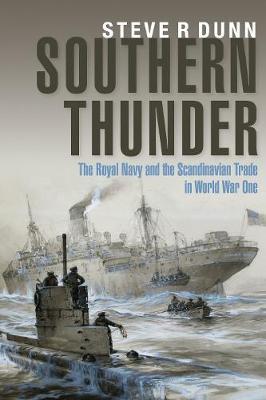Southern Thunder

Southern Thunder
This new book tells this little-known, and often ignored, story from both a naval and a political standpoint, revealing how each country, including the USA, tried to balance the needs of diplomacy with the necessities of naval warfare. Starting from the declaration of a British blockade and its impact and reception in Scandinavia, the narrative progresses to cover the struggle to prevent supplies reaching Germany, the negotiations to gain preferential British access to Scandinavian trade and the work of the sailors, both of the merchant marine and Royal Navy who had to make the system function. By the end of 1916, the British-Scandinavian trade was so important that a new system of convoyed vessels was developed, not without much Admiralty infighting, leading to the growth of naval operations all along the East Coast of Britain in places such as Immingham, Lerwick and Mehil.
Two years later, the Germans, desperate to break the tightening stranglehold, even brought out their big-gun ships to hunt and disrupt the Scandinavian convoys, and at one point US Navy battleships were perilously close to engaging with the High Sea Fleet as a result.
Detailed analysis and first-hand accounts of the fighting from those who took part create a vivid narrative that demonstrates how the Royal Navy helped to bring about Germany's downfall and protect Britain's vital Scandinavian supply lines.
PRP: 180.00 Lei
Acesta este Prețul Recomandat de Producător. Prețul de vânzare al produsului este afișat mai jos.
162.00Lei
162.00Lei
180.00 LeiLivrare in 2-4 saptamani
Descrierea produsului
This new book tells this little-known, and often ignored, story from both a naval and a political standpoint, revealing how each country, including the USA, tried to balance the needs of diplomacy with the necessities of naval warfare. Starting from the declaration of a British blockade and its impact and reception in Scandinavia, the narrative progresses to cover the struggle to prevent supplies reaching Germany, the negotiations to gain preferential British access to Scandinavian trade and the work of the sailors, both of the merchant marine and Royal Navy who had to make the system function. By the end of 1916, the British-Scandinavian trade was so important that a new system of convoyed vessels was developed, not without much Admiralty infighting, leading to the growth of naval operations all along the East Coast of Britain in places such as Immingham, Lerwick and Mehil.
Two years later, the Germans, desperate to break the tightening stranglehold, even brought out their big-gun ships to hunt and disrupt the Scandinavian convoys, and at one point US Navy battleships were perilously close to engaging with the High Sea Fleet as a result.
Detailed analysis and first-hand accounts of the fighting from those who took part create a vivid narrative that demonstrates how the Royal Navy helped to bring about Germany's downfall and protect Britain's vital Scandinavian supply lines.
Detaliile produsului










